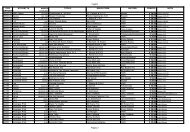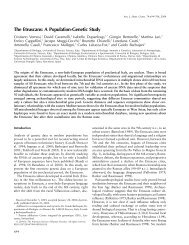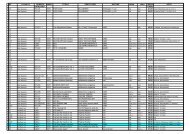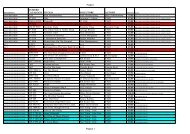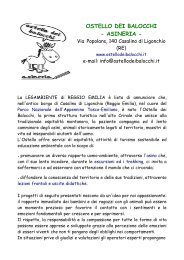A 28,000 Years Old Cro-Magnon mtDNA Sequence ... - web matic
A 28,000 Years Old Cro-Magnon mtDNA Sequence ... - web matic
A 28,000 Years Old Cro-Magnon mtDNA Sequence ... - web matic
Create successful ePaper yourself
Turn your PDF publications into a flip-book with our unique Google optimized e-Paper software.
A <strong>28</strong>,<strong>000</strong> <strong>Years</strong> <strong>Old</strong> <strong>Cro</strong>-<strong>Magnon</strong> <strong>mtDNA</strong> <strong>Sequence</strong><br />
Differs from All Potentially Contaminating Modern<br />
<strong>Sequence</strong>s<br />
David Caramelli 1 , Lucio Milani 1 , Stefania Vai 1,2 , Alessandra Modi 1 , Elena Pecchioli 3 , Matteo Girardi 3 ,<br />
Elena Pilli 1 , Martina Lari 1 , Barbara Lippi 4 , Annamaria Ronchitelli 5 , Francesco Mallegni 4 , Antonella<br />
Casoli 6 , Giorgio Bertorelle 2 , Guido Barbujani 2 *<br />
1 Dipartimento di Biologia Evoluzionistica, Università di Firenze, Firenze, Italy, 2 Dipartimento di Biologia ed Evoluzione , Università di Ferrara, Ferrara, Italy, 3 Centro di<br />
Ecologia Alpina Fondazione Edmund Mach, Viote del Monte Bondone, Trento, Italy, 4 Dipartimento di Biologia, Università di Pisa, Pisa, Italy, 5 Dipartimento di<br />
Dipartimento di Scienze Ambientali , Università di Siena, Siena, Italy, 6 Dipartimento di Chimica Generale e Inorganica, Chimica Analitica, Chimica Fisica, Università di<br />
Parma, Parma, Italy<br />
Abstract<br />
Background: DNA sequences from ancient speciments may in fact result from undetected contamination of the ancient<br />
specimens by modern DNA, and the problem is particularly challenging in studies of human fossils. Doubts on the<br />
authenticity of the available sequences have so far hampered genetic comparisons between anatomically archaic<br />
(Neandertal) and early modern (<strong>Cro</strong>-Magnoid) Europeans.<br />
Methodology/Principal Findings: We typed the mitochondrial DNA (<strong>mtDNA</strong>) hypervariable region I in a <strong>28</strong>,<strong>000</strong> years old<br />
<strong>Cro</strong>-Magnoid individual from the Paglicci cave, in Italy (Paglicci 23) and in all the people who had contact with the sample<br />
since its discovery in 2003. The Paglicci 23 sequence, determined through the analysis of 152 clones, is the Cambridge<br />
reference sequence, and cannot possibly reflect contamination because it differs from all potentially contaminating modern<br />
sequences.<br />
Conclusions/Significance:: The Paglicci 23 individual carried a <strong>mtDNA</strong> sequence that is still common in Europe, and which<br />
radically differs from those of the almost contemporary Neandertals, demonstrating a genealogical continuity across<br />
<strong>28</strong>,<strong>000</strong> years, from <strong>Cro</strong>-Magnoid to modern Europeans. Because all potential sources of modern DNA contamination are<br />
known, the Paglicci 23 sample will offer a unique opportunity to get insight for the first time into the nuclear genes of early<br />
modern Europeans.<br />
Citation: Caramelli D, Milani L, Vai S, Modi A, Pecchioli E, et al. (2008) A <strong>28</strong>,<strong>000</strong> <strong>Years</strong> <strong>Old</strong> <strong>Cro</strong>-<strong>Magnon</strong> <strong>mtDNA</strong> <strong>Sequence</strong> Differs from All Potentially<br />
Contaminating Modern <strong>Sequence</strong>s. PLoS ONE 3(7): e2700. doi:10.1371/journal.pone.<strong>000</strong>2700<br />
Editor: Henry Harpending, University of Utah, United States of America<br />
Received April 23, 2008; Accepted June 17, 2008; Published July 16, 2008<br />
Copyright: ß 2008 Caramelli et al. This is an open-access article distributed under the terms of the Creative Commons Attribution License, which permits<br />
unrestricted use, distribution, and reproduction in any medium, provided the original author and source are credited.<br />
Funding: Study supported by funds of the Italian Ministery of the Universities (PRIN 2006). No sponsors had any role in any phase of the study, and the authors<br />
do not envisage any conflict of interests.<br />
Competing Interests: The authors have declared that no competing interests exist.<br />
* E-mail: g.barbujani@unife.it<br />
Introduction<br />
The anatomically-archaic Europeans, the Neandertal people,<br />
are documented in the fossil record from approximately 300,<strong>000</strong><br />
to 30,<strong>000</strong> years ago. Around 45,<strong>000</strong> years ago, anatomicallymodern<br />
humans of the <strong>Cro</strong>-Magnoid type expanded in<br />
Europe from the Southeast. Neandertals coexisted with them for<br />
between 1,<strong>000</strong> to 10,<strong>000</strong> thousand years, depending on the region<br />
[1], but eventually their skeletons disappeared from the fossil<br />
record. Individuals of intermediate morphology have not been<br />
observed. With the possible exception of one 25,<strong>000</strong> years old<br />
child [2], all known specimens in the relevant time interval can be<br />
classified without ambiguity either as Neandertals or <strong>Cro</strong>-<br />
Magnoids.<br />
The interpretation of these findings is not straightforward.<br />
Under the so-called Out-of-Africa model, Neandertals are<br />
considered to be extinct, and modern Europeans are regarded as<br />
descending exclusively from <strong>Cro</strong>-Magnoids who replaced Neandertals<br />
in the course of their expansion from Africa [3].<br />
Conversely, recent versions of the alternative, multiregional<br />
model, propose that Neandertals gave a limited, but nonnegligible,<br />
contribution to the gene pool of modern Europeans<br />
by admixing with <strong>Cro</strong>-Magnoids (e.g. [4–6]). Analyses of<br />
morphological traits [7], ancient Neandertal DNA [8,9], and<br />
modern DNA diversity [10–12] are generally regarded as<br />
supporting a recent African origin of modern humans [13],<br />
without substantial Neandertal contribution, if any at all. In<br />
particular, <strong>mtDNA</strong> sequences from all studied Neandertals fall out<br />
of the range of modern variation and show no particular<br />
relationship with modern European sequences [9,14]. However,<br />
it is clearly impossible to rule out any degree of reproductive<br />
interaction between the two groups. As a consequence, the<br />
possibility has been raised that admixture did occur, but the early<br />
Europeans of modern anatomy were not too different genetically<br />
PLoS ONE | www.plosone.org 1 July 2008 | Volume 3 | Issue 7 | e2700
from Neandertals, or else that most Neandertal haplotypes were<br />
lost through a process of lineage sorting, i.e. by genetic drift [5].<br />
To clarify the evolutionary relationships between the two<br />
anatomically-distinct groups that coexisted in Upper Paleolithic<br />
Europe, data on DNA variation in <strong>Cro</strong>-Magnoids are of course<br />
extremely important. At present, only two <strong>Cro</strong>-Magnoid sequences,<br />
both from Paglicci in Southern Italy, have been published. Both of<br />
them fall within the range of modern <strong>mtDNA</strong> variation, thus<br />
differing sharply from all known Neandertal sequences, and both<br />
belong to fossil specimens from which Neandertal-specific primers<br />
failed to amplify <strong>mtDNA</strong> [15]. Serre et al. [16] confirmed that <strong>Cro</strong>-<br />
Magnoid <strong>mtDNA</strong>s could not be amplified using Neandertal-specific<br />
primers, but argued that the Paglicci sequences, as well as all ancient<br />
sequence that appear modern, cannot be considered reliable because<br />
contamination of ancient samples by modern DNA can be proved,<br />
but absence of contamination cannot.<br />
Undetected contamination is doubtless a serious problem in<br />
ancient human DNA study, as shown by the presence of modern<br />
human DNA in samples that should not naturally contain it [16–<br />
20]. However, the fact that such contamination can and does<br />
occur does not imply that it cannot be recognized [21].<br />
Presumably, modern DNA tends to permeate in the pulp cavity<br />
of the teeth through dentinal tubules, and in the bone through the<br />
Haversian system [22], although possibly not reaching the<br />
osteocytes [18,19]. The main causes of contamination are the<br />
direct handling and washing of the specimens, most likely in the<br />
phase immediately after excavation [22,23].<br />
In this study we had the unique opportunity to characterize<br />
genetically a <strong>Cro</strong>-Magnoid individual, Paglicci 23, whose<br />
tafonomic history is perfectly known. As a consequence, we could<br />
monitor all possible contaminations from the individuals who<br />
manipulated the sample. In this way, testing for contamination<br />
meant comparing the sequence obtained from the Paglicci 23<br />
bones with the sequences of all modern people who touched them,<br />
and not with generic and hard-to define modern sequences. We<br />
showed that: (i) the mitochondrial sequence inferred from the<br />
analysis of the Paglicci 23 <strong>mtDNA</strong> hypervariable region I (HVR I)<br />
cannot possibly be due to contamination by anybody who<br />
manipulated the sample ever since its discovery in 2003, and (2)<br />
this <strong>28</strong>,<strong>000</strong> years old sequence is still common in Europe, and is<br />
the Cambridge reference sequence (CRS).<br />
Results and Discussion<br />
The fragmentised remains (tibia, skulls, jaw and maxilla) of a<br />
<strong>Cro</strong>-<strong>Magnon</strong> individual, named Paglicci 23, were excavated by<br />
F.M in 2003 from the Paglicci cave, Southern Italy. Radiocarbon<br />
tests dated the layer to <strong>28</strong>.100 (+/2350) years ago [24]. Because of<br />
its fragmentary nature, the sample was neither restored nor<br />
studied from the morpho-anatomical point of view. Therefore, no<br />
contamination could possibly be introduced at these stages by<br />
direct handling and washing. The remains were deposited in the<br />
storage room at controlled temperature in the Department of<br />
Archaeology, University of Pisa. In 2005 three splinters, a piece of<br />
tibia (Figure 1) and two pieces of skull, were moved to the ancient<br />
DNA laboratory at the University of Florence. In the course of the<br />
whole process, from excavation of the remains to genetic typing,<br />
only seven persons had any contacts with the sample, namely six of<br />
us (F.M, S.V, A.M., E.Pi., M.L., and D.C.) and Carles Lalueza-<br />
Fox (hereafter: C.L.) who replicated the sequence at the University<br />
Pompeu Fabra, Barcelona.<br />
The degree of racemization of three amino acids, aspartic acid,<br />
alanine, and leucine, provides indirect evidence as for the presence in<br />
an ancient sample of amplifiable DNA. In particular, DNA is<br />
<strong>Cro</strong>-<strong>Magnon</strong> Mitochondrial DNA<br />
Figure 1. Tibia fragment of the Paglicci 23 specimen. DNA was<br />
extracted from this fragment and from skull splinters, and all extracts<br />
yielded the same HVR I sequence.<br />
doi:10.1371/journal.pone.<strong>000</strong>2700.g001<br />
expected to be too degraded for amplification when the D/L for Asp<br />
is greater than 0.08 [25]. As a preliminary test of macromolecule<br />
preservation, we measured the stereoisomeric D/L ratio for these<br />
amino acids. The observed values, all of them compatible with good<br />
preservation of biological macromolecules in the sample, were D/L<br />
Asp 0.0479, D/L Glu 0.0104 D/L, Ala 0.0092. The global amino<br />
acid content was 42,589 parts per million, and endogenous DNA<br />
was successfully ampified from Pleistocene remains when this value<br />
was higher than 30,<strong>000</strong> parts per million [16].<br />
Quantitative PCR showed a relatively large amount of <strong>mtDNA</strong><br />
molecules in the Paglicci 23 fossil, approximately 2300. Contamination,<br />
usually detected when different sequences are observed in<br />
different cloned products, is considered unlikely if the number of<br />
PCR template molecules is .1,<strong>000</strong> [26]. We thus proceeded in the<br />
analysis by initially sequencing a total of 144 clones (Table S1),<br />
respectively 64, 32 and 48 for the three regions in which the HVR<br />
I was divided. Reproducible <strong>mtDNA</strong> sequences corresponding to<br />
positions 16024–16383 of the published reference sequence CRS<br />
[27] were obtained in the Florence laboratory from the tibia and<br />
from a skull fragment of Paglicci 23. No contamination was<br />
observed in the extractions and PCR blanks. Amplification of long<br />
DNA fragments, unusual for ancient DNA, was not observed. The<br />
analysis was repeated in Barcelona, using a tibia fragment; the<br />
consensus sequence obtained from 8 clones covering the region<br />
between nt 16245 to nt 16349 was identical to that obtained in<br />
Florence. On the contrary, no PCR product was observed when<br />
we attempted to amplify the DNA extracts using two pairs of<br />
Neandertal-specific primers.<br />
As is common in studies of ancient DNA, when comparing<br />
sequences across clones we observed single nucleotide substitutions<br />
occurring in one or a few clones (Table S1), on average 3.9 every<br />
1,<strong>000</strong> bp. In addition, a C to T change was observed in 27 out of<br />
56 clones at nt 16274. In principle, differences of this kind across<br />
clones may be due to three factors, namely: (1) sequence<br />
heterogeneity due to the presence of exogenous, contaminating<br />
DNA, (2) post-mortem DNA damage, and (3) Taq-polymerase<br />
PLoS ONE | www.plosone.org 2 July 2008 | Volume 3 | Issue 7 | e2700
Table 1. Mitochondrial HVR1 variation in the seven<br />
researchers that have been in physical contact with the<br />
samples.<br />
Researcher Task HVR1 haplotype<br />
F.M Excavation 16069 T, 16126 C, 16278 T, 16294 T, 16366 T<br />
S.V Laboratory analysis 16311 C<br />
A.M Laboratory analysis 16274 A 16311 C<br />
M.L Laboratory analysis 16261 T, 16311 C<br />
E.Pi Laboratory analysis 16096 A, 16126 C, 16145 A, 16189 C,<br />
16231C, 16260 T, 16261 T,<br />
C.L. Laboratory analysis 16126 C, 16294 T, 16296 T, 16304 C<br />
D.C. Laboratory analysis 16193 T, 16278 T<br />
doi:10.1371/journal.pone.<strong>000</strong>2700.t001<br />
errors or cloning artefacts. We tested separately for the possible<br />
effects of the first two factors upon our specimen.<br />
To track down any possible modern contaminations, the<br />
<strong>mtDNA</strong>s of the seven authors who to any extent manipulated<br />
the sample were genotyped. All these sequences (Table 1) differ<br />
from the Paglicci 239s consensus <strong>mtDNA</strong> sequence. However, two<br />
of (F.M and C.L) have a T at nt 16274. Therefore, variation across<br />
clones at that site might have meant that either investigator left his<br />
DNA on the sample, although C.L. had no contacts with the<br />
material at the stage at which clones F2.1 through F2.13 and F3.1<br />
through F3.15 were genotyped.<br />
Post-mortem DNA damage generally occurs in the form of<br />
double-strand breaks, or other modifications severe enough to<br />
prevent enzy<strong>matic</strong> replication of the DNA molecule. Had this<br />
happen, we would have been unable to amplify the DNA.<br />
However, hydrolytic deamination and depurination may also<br />
occur, resulting in apparent changes of the nucleotide sequence.<br />
Although post-mortem damages of this kind are unlikely to<br />
severely bias the results when the initial template molecules exceed<br />
1<strong>000</strong> [26] as is the case for Paglicci 23, to correct for such possible<br />
post-mortem damages, a third DNA extract was treated with<br />
Uracyl-N-Glycosidase (UNG) [17], and independently resequenced.<br />
The 35 sequences thus obtained (clones F 4.1 through<br />
F4.20, and F5.1 through F 5.15) contain no nucleotide<br />
substitutions with respect to the CRS, including nt 16274 (Table<br />
S1). As a consequence, we concluded that the sequence obtained<br />
from the Paglicci 23 specimen is the CRS, and that heterogeneity<br />
across clones at nt 16274 reflects DNA damage due to<br />
deamination of the original cytosine and successive amplification<br />
of the damaged DNA fragment(s). The rate of nucleotide<br />
misincorporation suggests that the DNA templates were indeed<br />
damaged (3.9 substitutions every 1,<strong>000</strong> bp within the HVRI), but<br />
after UNG treatment at least 82% of the clones showed the same<br />
consensus nucleotide at each position (Table S1).<br />
The relationship between the Paglicci 23 sequence, the available<br />
<strong>Cro</strong>-<strong>Magnon</strong> and Neandertal sequences, and all the sequences from<br />
the seven individuals who manipulated the <strong>Cro</strong>-<strong>Magnon</strong>s specimen,<br />
are summarized in Figure 2. The backbone of the network is based<br />
on the 31bp region for which we had complete overlap among all<br />
sequences, and was estimated by a statistical parsimony method [<strong>28</strong>],<br />
as implemented in the software TCS [29]. A sub-network was also<br />
reconstructed for a set of eight individuals relevant to this study using<br />
the entire fragment of 360 bp.<br />
Previous genetic data on <strong>Cro</strong>-Magnoids [15], although generated<br />
under the most stringent available criteria, were considered<br />
proble<strong>matic</strong> by some authors [16,30], because the <strong>mtDNA</strong><br />
sequences obtained correspond to sequences also observed in<br />
modern individuals. For most ancient human samples, rigorous<br />
application of this criterion would render the study of <strong>Cro</strong>-Magnoid<br />
DNA practically impossible, because it is impossible to rule out any<br />
contamination from generic unknown individuals. However, it is<br />
possible to test for the occurrence in the extract of known potential<br />
contaminating sequences; for the Paglicci 23 fossil we had this<br />
opportunity, and we found that none of these modern sequences is<br />
equal to the sequence obtained from the fossil extracts. Since we used<br />
different sets of overlapping primers pairs to amplify the fragment<br />
included between nucleotide 16024 and 16383, it seems highly<br />
unlikely that the sequence obtained was a chimera artefact.<br />
Therefore, at this stage it is safe to conclude that at least one <strong>Cro</strong>-<br />
Magnoid <strong>mtDNA</strong> sequence, for which contamination can be ruled<br />
out with a high degree of confidence, falls well within the range of<br />
modern human variation. This does not prove, but at least indirectly<br />
suggests, that the previously published <strong>Cro</strong>-Magnoid sequences [15],<br />
both documented in the modern human gene pool, may be genuine<br />
[31]. At any rate, the finding of the Cambridge Reference <strong>Sequence</strong><br />
in Paglicci 23 shows that one of today’s <strong>mtDNA</strong> variants has been<br />
present in Europe for at least <strong>28</strong>,<strong>000</strong> years, and that modern and<br />
archaic anatomical features appear associated with <strong>mtDNA</strong><br />
sequences that can be classified, respectively, as modern and nonmodern.<br />
Because no HVR I sequence similar to the Neandertals’ has<br />
been described in more than 4800 Europeans studied so far [32],<br />
models whereby Neandertals were part of the genealogy of current<br />
Europeans are at odds with the data, at least as far as maternal<br />
inheritance is concerned. In our opinion, the burden of the proof is<br />
now on those who maintain that Neandertals might have<br />
contributed to the modern gene pool.<br />
So far, the study of ancient nuclear DNA in humans has been<br />
severely limited by the difficulty to ascertain whether the DNA<br />
sequences obtained are really endogenous to the specimen. This<br />
study shows that it is possible to test for DNA authenticity, provided<br />
the people who manipulate the sample from the moment of<br />
excavation are carefully recorded and their DNAs typed. Therefore,<br />
Paglicci 23 (as well as other remains studied under comparable<br />
conditions in the future) promises to be a valuable source of<br />
information on DNA diversity in the past, and can pave the ground<br />
for a more exhaustive understanding of human evolutionary history.<br />
Materials and Methods<br />
<strong>Cro</strong>-<strong>Magnon</strong> Mitochondrial DNA<br />
Figure 2. Genetic relationships among the Paglicci 23 and<br />
other relevant <strong>mtDNA</strong> sequences. The network summarizes<br />
<strong>mtDNA</strong> HVR I variation in 13 Neandertals (Nea1 to Nea13) , three <strong>Cro</strong>-<br />
<strong>Magnon</strong>s (CrM1 to CrM3), and seven modern humans who manipulated<br />
the <strong>Cro</strong>-<strong>Magnon</strong>s specimens (six authors of this paper and Carles<br />
Laueza-Fox, designated by their initials).<br />
doi:10.1371/journal.pone.<strong>000</strong>2700.g002<br />
DNA extraction<br />
All DNA-preparation and extraction methods followed strictly<br />
specific ancient DNA requirements [33]. DNA was extracted in<br />
PLoS ONE | www.plosone.org 3 July 2008 | Volume 3 | Issue 7 | e2700
two laboratories, in Florence and Barcelona, in facilities<br />
exclusively dedicated to ancient DNA work. All DNA extractions<br />
and PCR set up were carried out in physically separated spaces<br />
from those in which PCR cyclings and post-PCR analysis was<br />
conducted. Full-body suits, disposable masks and gloves were worn<br />
throughout and were changed frequently, and pipettors were UVirradiated<br />
in between use. All DNA extractions and PCR reactions<br />
included negative controls, and all steps of the analysis were<br />
replicated at least twice in each laboratory. To test for preservation of<br />
other macromolecules as an indirect evidence for DNA survival [26]<br />
we estimated the degree of aminoacid racemization, in each sample,<br />
using approximately 5 mg of tibia and skull, powdered following the<br />
procedures described in [25]. We quantified the amount of target<br />
DNA by Real Time (RT) PCR. PCR products were cloned, 152<br />
clones were sequenced, and the sequences thus obtained were<br />
aligned and compared across clones. After extraction, UNG<br />
treatment were performed on a third skull fragment in order to<br />
verify whether C to T changes (nt 16294 ) observed in some clones<br />
represented postmortem damage or contamination [17].<br />
To prevent contamination from prior handling, the outer layer<br />
of bones was removed with a rotary tool, and the fragments were<br />
briefly soaked in 10% bleach. Both samples were then irradiated (1<br />
hour under UV light) and powdered. DNA was extracted by<br />
means of a silica-based protocol [15]. At least two independent<br />
extracts were obtained from each remain. Multiple negative<br />
controls were included in each extraction.<br />
UNG treatment<br />
Uracil bases caused by the hydrolytic deamination of cytosines<br />
were excised by treating 10 ml of DNA extracted from both<br />
samples with 1U of Uracil-N-Glycosylase (UNG) for 30 min at<br />
37uC. UNG reduces sequence artefacts caused by this common<br />
form of post-mortem damage, resulting in apparent C to T/G to A<br />
mutations and subsequent errors in the sequence results [17]. After<br />
this treatment, the extract was subjected to the same PCR Cloning<br />
and sequencing conditions as described above.<br />
Quantification of DNA Molecules<br />
Real-time PCR amplification was performed using BrilliantH<br />
SYBRH Green QPCR Master Mix (Stratagene) in MX3<strong>000</strong>P<br />
(Stratagene), using 0.5mM of appropriate primers (forward primer<br />
located at H 16107 and reverse primer located at L 16261.<br />
Thermal cycling conditions were 95uC for 10 min, 40 cycles at<br />
95uC for 30 s, 53uC for 1 min and 72uC for 30 s, followed by<br />
SYBRH Green dissociation curve steep. Ten-fold serial dilutions of<br />
the purified and quantified standard were included in the<br />
experiment to create the standard curve in order to know the<br />
number of initial DNA molecules in the samples<br />
Amplification of mt DNA<br />
Two ml of DNA extracted from the bone were amplified with<br />
this profile: 94uC for 10 min (Taq polymerase activation), followed<br />
by 50 cycles of PCR (denaturation , 94uC for 45 sec, annealing,<br />
53uC for 1 min and extension, 72uC for 1 min) and final step at<br />
72uC for 10 min. The 50 ml reaction mix contained 2 U of<br />
AmpliTaq Gold (Applied Biosystems), 200 mM of each dNTP and<br />
1 mM of each primer. The 360 bp long HVR-I was subdivided in<br />
three overlapping fragments using the following primer pairs:<br />
L15995/H16132; L16107/H16261; L16247/H16402. Each extract<br />
was amplified at least twice. Since overlapping primers were<br />
used throughout the PCR amplifications, it is highly unlikely that<br />
we amplified a nuclear insertion rather than the organellar<br />
<strong>mtDNA</strong>. Reactions conditions in replay analysis were described in<br />
[34], except for the sequences primers that we report as follows:<br />
59ACTATCACACATCAACTGC 39; 59ATGGGGACGAGAA-<br />
GGGATTT 39.<br />
Cloning and Sequencing<br />
PCR products were cloned using TOPO TA Cloning Kit<br />
(Invitrogen) according to the manufacturer’s instructions. Screening<br />
of white recombinant colonies was accomplished by PCR,<br />
transferring the colonies into a 30 ml reaction mix (67 mM Tris<br />
HCl [pH 8.8], 2 mM MgCl2, 1mM of each primer, 0.125 mM of<br />
each dNTP, 0,75 units of Taq Polymerase) containing M13<br />
forward and reverse universal primers. After 5 min at 92u C, 30<br />
cycles of PCR (30 sec at 90uC, 1 min at 50uC, 1 min at 72uC)<br />
were carried out and clones with insert of the expected size were<br />
identified by agarose gel electrophoresis. After purification of these<br />
PCR products with Microcon PCR devices (Amicon), a volume of<br />
1,5 ml was cycle-sequenced following the BigDye Terminator kit<br />
(Applied Biosystems) supplier’s instructions. The sequence was<br />
determined using an Applied BioSystems 3100 DNA sequencer.<br />
‘‘Long’’ amplificate detection<br />
Appropriate molecular behaviour was also tested by amplification<br />
of longer <strong>mtDNA</strong> fragments (443 bp and 724 bp), which have<br />
been reported as very unusual for ancient DNA. PCR conditions<br />
were those described for <strong>mtDNA</strong> analysis above, primers used for<br />
443 bp fragment were L15995 and H16401, while for 724 bp<br />
fragment primers used were L16247 and H00360.<br />
Amplification with Neandertal-specific primers<br />
Amplifications of the Paglicci extracts with two pairs of<br />
Neandertal-specific primers (L16,022-NH16,139 and NL16,263/<br />
264-NH16,400, [14]) were also attempted. 50 ml of DNA were<br />
amplified with the following profile: 94uC for 10 min and 45 cycles<br />
of a denaturation (94uC for 45 sec), annealing (57uC for 1 min for<br />
the first couple and 59uC for 1 min for the second couple) and<br />
extension step (72uC for 1 min). The 50 ml reaction mix contained<br />
2 U of AmpliTaq Gold polymerase and 16 reaction buffer<br />
(Applied Biosystems), 200 mM of each dNTP, 1.5mM MgCl2,<br />
1 mM of each primer.<br />
Extractions amplifications and sequencing of modern<br />
DNA<br />
MtDNA genotypes of all individuals who had any contacts with<br />
the specimen were either known in advance (M.L., D.C. and<br />
C.L.F: [21]), or determined in the Laboratory at Viote Trento<br />
(S.V., E.Pi., A.M., F.M.). Buccal cells were collected by oral<br />
brushes (Sterile Omni Swab or Sterile Foam Tipped Swabs,<br />
Whatman International Ltd., Maidstone, UK) and DNA was<br />
extracted using QIAmp1 DNA Mini Kit (QIAGEN, Hagen,<br />
Germany) according to manufacturer’s instructions. The hypervariable<br />
region I (HVR1) of the <strong>mtDNA</strong> was determined by PCR<br />
amplification using the primers L15996 (59CTCCACCATTAG-<br />
CACCCAAAGC 93) and H408 (59 CTGTTAAAAGTGCA-<br />
TACCGCC 93) (Table S1).<br />
Supporting Information<br />
<strong>Cro</strong>-<strong>Magnon</strong> Mitochondrial DNA<br />
Table S1 <strong>Sequence</strong>s of the clones obtained by amplifying the<br />
HVR I of <strong>mtDNA</strong> from the Paglicci 23 fossil. A dot indicates<br />
identity with respect to the Cambridge Reference <strong>Sequence</strong>, as<br />
modified by Ruiz-Pesini et al. [26], a letter indicates a nucleotide<br />
substitution. In the first column, labels designate clones sequenced,<br />
respectively, in the Florence (those beginning with an F) or<br />
Barcelona (those beginning with a B) laboratories. Bold type: clone<br />
PLoS ONE | www.plosone.org 4 July 2008 | Volume 3 | Issue 7 | e2700
sequences after UNG treatment. The sequences of the primers are<br />
also reported.<br />
Found at: doi:10.1371/journal.pone.<strong>000</strong>2700.s001 (0.09 MB<br />
DOC)<br />
Acknowledgments<br />
We would like to thank Carles Lalueza Fox, who replicated the sequences<br />
in his laboratory at the University Pompeu Fabra, Barcelona, Spain, and<br />
Agnar Helgason for his comments and suggestions.<br />
References<br />
1. Mellars P (2006a) A new radiocarbon revolution and the dispersal of modern<br />
humans in Eurasia. Nature 439: 931–935.<br />
2. Zilhão J (2006) Neandertals and moderns mixed, and it matters. Evol Anthropol<br />
15: 183–195.<br />
3. Stringer C (2002) Modern human origins: progress and prospects. Philos<br />
Trans R Soc Lond B Biol Sci 357: 563–579.<br />
4. Relethford JH (2001) Absence of regional affinities of Neandertal DNA with<br />
living humans does not reject multiregional evolution. Am J Phys Anthropol 115:<br />
95–98.<br />
5. Relethford JH (2007) Genetic evidence and the modern human origins debate.<br />
Heredity 100: 555–563.<br />
6. Wolpoff MH (2005) Multiregional Evolution. In: Renfrew C, Bahn P, eds.<br />
Archaeology: The Key Concepts. London: Routledge. pp 176–181.<br />
7. Manica A, Amos W, Balloux F, Hanihara T (2007) The effect of ancient<br />
population bottlenecks on human phenotypic variation. Nature 448: 346–348.<br />
8. Krings M, Capelli C, Tschentscher F, Geisert H, Meyer S, et al. (2<strong>000</strong>) A view of<br />
Neandertal genetic diversity. Nat Genet 26: 144–146.<br />
9. Lalueza-Fox C, Krause J, Caramelli D, Catalano G, Milani L, et al. (2006)<br />
Mitochondrial DNA of an Iberian Neandertal suggests a population affinity with<br />
other European Neandertals. Curr Biol. 16: R629–R630.<br />
10. Currat M, Excoffier L (2004) Modern humans did not admix with Neanderthals<br />
during their range expansion into Europe. PLoS Biol. 12: e421.<br />
11. Liu H, Prugnolle F, Manica A, Balloux FA (2006) Geographically explicit<br />
genetic model of worldwide human-settlement history. Am J Hum Genet 79:<br />
230–237.<br />
12. Ramachandran S, Deshpande O, Roseman CC, Rosenberg NA, Feldman MW,<br />
et al. (2005) Support from the relationship of genetic and geographic distance in<br />
human populations for a serial founder effect originating in Africa. Proc Natl<br />
Acad Sci USA 102: 15942–15947.<br />
13. Mellars P (2006b) Going east: New genetic and archaeological perspectives on<br />
the modern human colonization of Eurasia. Science 313: 796–800.<br />
14. Caramelli D, Lalueza-Fox C, Condemi S, Longo L, Milani L, et al. (2006) A<br />
highly divergent <strong>mtDNA</strong> sequence in a Neandertal individual from Italy. Curr.<br />
Biol. 16: R630–R632.<br />
15. Caramelli D, Lalueza-Fox C, Vernesi C, Lari M, Casoli A, et al. (2003) Evidence<br />
for a genetic discontinuity between Neandertals and 24,<strong>000</strong>-year-old anatomically<br />
modern Europeans. Proc Natl Acad Sci USA. 100(11): 6593–7.<br />
16. Serre D, Langaney A, Chech M, Teschler-Nicola M, Paunovic M, et al. (2004)<br />
No evidence of Neandertal <strong>mtDNA</strong> contribution to early modern humans. PLoS<br />
Biol 3: E57.<br />
17. Hofreiter M, Jaenicke V, Serre D, van Haeseler A, Pääbo S (2001) DNA<br />
sequences from multiple amplifications reveal artifacts induced by cytosine<br />
deamination in ancient DNA Nucleic Acids Res 29: 4793–4799.<br />
<strong>Cro</strong>-<strong>Magnon</strong> Mitochondrial DNA<br />
Author Contributions<br />
Conceived and designed the experiments: DC GB. Performed the<br />
experiments: LM SV AM EP MG EP ML AC. Analyzed the data: GB<br />
GB. Wrote the paper: DC FM GB. Collected the sample: BL FM. Dated<br />
the sample: BL AR. Participated in preliminary tests of macromolecule<br />
preservation: AC.<br />
18. Malmström H, Stora˚ J, Dalén L, Holmlund G, Götherström A (2005) Extensive<br />
human DNA contamination in extracts from ancient dog bones and teeth. Mol<br />
Biol Evol 10: 2040–2047.<br />
19. Salamon M, Tuross N, Arensburg B, Weiner S (2005) Relatively well preserved<br />
DNA is present in the crystal aggregates of fossil bones. Proc Natl Acad Sci USA<br />
39: 13783–13788.<br />
20. Lalueza-Fox C, Sampietro ML, Caramelli D, Puder Y, Lari M, et al. (2005)<br />
Neandertal evolutionary genetics: mitochondrial DNA data from the Iberia<br />
peninsula. Mol Biol Evol 22: 1077–81.<br />
21. Sampietro ML, Gilbert MT, Lao O, Caramelli D, Lari M, et al. (2006) Tracking<br />
down human contamination in ancient human teeth. Mol Biol Evol 23:<br />
1801–1807.<br />
22. Gilbert MTP, Rudbeck L, Willerslev E, Hansen HJ, Smith C, et al. (2005)<br />
Biochemical and physical correlates of DNA contamination in archaeological<br />
human bones and teeth excavated at Matera, Italy. J Archaeol Sci 32: 783–95.<br />
23. Gilbert MTP, Hansen AJ, Willerslev E, Turner-Walker G, Collins M (2006)<br />
Insights into the processes behind the contamination of degraded human teeth<br />
and bone samples with exogenous sources of DNA. Int J Osteoarcheol 16(2):<br />
156–64.<br />
24. Mallegni F (2005) Catalogue of Italian fossil human remains from the<br />
Palaeolithic to the Mesolithic. J Anthropol Sci 84 (Suppl.): 110.<br />
25. Poinar HN, Hoss M, Bada JL, Pääbo S (1996) Amino acid racemization and the<br />
preservation of ancient DNA. Science 272: 864–866.<br />
26. Handt O, Krings M, Ward RM, Pääbo S (1996) The retrieval of ancient human<br />
DNA sequences. Am J Hum Genet 59: 368–376.<br />
27. Ruiz-Pesini E, Lott MT, Procaccio V, Poole J, Brandon MC, et al. (2007) An<br />
enhanced MITOMAP with a global <strong>mtDNA</strong> mutational phylogeny. Nucleic<br />
Acids Res 35: D823–D8<strong>28</strong>.<br />
<strong>28</strong>. Templeton AR, Crandall KA, Sing CF (1992) A cladistic analysis of phenotypic<br />
associations with haplotypes inferred from restriction endonuclease mapping and<br />
DNA sequence data. III. Cladogram estimation. Genetics 132: 619–633.<br />
29. Clement M, Posada D, Crandall KA (2<strong>000</strong>) TCS: a computer program to<br />
estimate gene genealogies. Mol Ecol 9: 1657–19.<br />
30. Abbott A (2003) Anthropologists cast doubt on human DNA evidence. Nature<br />
423: 468–468.<br />
31. Barbujani G, Bertorelle G (2003) Were <strong>Cro</strong>-<strong>Magnon</strong>s too like us for DNA to<br />
tell? Nature 424: 127.<br />
32. http://<strong>web</strong>.unife.it/progetti/genetica/pdata.htm/PopList.xls.<br />
33. Cooper A, Poinar H (2<strong>000</strong>) Ancient DNA: do it right or not at all. Science <strong>28</strong>9:<br />
1139.<br />
34. Sampietro ML, Lao O, Caramelli D, Lari M, Pou R, et al. (2007) Palaeogenetic<br />
evidence supports a dual model of Neolithic spreading into Europe. Proc Biol Sci<br />
274: 2161–2167.<br />
PLoS ONE | www.plosone.org 5 July 2008 | Volume 3 | Issue 7 | e2700



